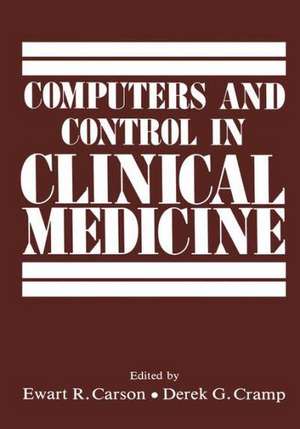Computers and Control in Clinical Medicine
Autor Ewart R. Carson, Derek G. Crampen Limba Engleză Paperback – 27 sep 2011
Preț: 371.30 lei
Preț vechi: 390.84 lei
-5% Nou
Puncte Express: 557
Preț estimativ în valută:
71.06€ • 73.91$ • 58.66£
71.06€ • 73.91$ • 58.66£
Carte tipărită la comandă
Livrare economică 15-29 aprilie
Preluare comenzi: 021 569.72.76
Specificații
ISBN-13: 9781461294825
ISBN-10: 1461294827
Pagini: 276
Ilustrații: X, 264 p. 21 illus.
Dimensiuni: 178 x 254 x 14 mm
Greutate: 0.48 kg
Ediția:1985
Editura: Springer Us
Colecția Springer
Locul publicării:New York, NY, United States
ISBN-10: 1461294827
Pagini: 276
Ilustrații: X, 264 p. 21 illus.
Dimensiuni: 178 x 254 x 14 mm
Greutate: 0.48 kg
Ediția:1985
Editura: Springer Us
Colecția Springer
Locul publicării:New York, NY, United States
Public țintă
ResearchCuprins
Control System Concepts and Approaches in Clinical Medicine.- The Diagnosis and Treatment of Disease.- A Control System Approach to Medical Treatment.- Models and the Modelling Process.- The Application of Models in Control System Approaches.- Summary.- References.- The Role of Biodynamic Models in Computer-Aided Diagnosis.- The Diagnostic Process.- Diagnostic Methods in Medicine.- Computer-Aided Diagnosis.- Biodynamic Models as Diagnostic Aids.- Biodynamic Models and Computer-Aided Diagnostic Systems.- Clinical Acceptability of Models.- Acknowledgment.- References.- Clinical Decision Making in Relation to Laboratory Investigation: The Role of the Computer.- Investigations and Clinical Judgment.- What is Disease?.- You Cannot Get an Answer until You Ask a Question.- The Reference Range.- Computer-Assisted Decision Support Systems.- Some Approaches to CADSS.- Expert Systems.- Patterns of Future Development.- Further Reading.- Clinical Decision Making Using Pharmacokinetic and Pharmacodynamic Data.- Use of Pharmacokinetic Data.- Use of Pharmacodynamic Data.- Conclusion.- References.- Closed Loop Control.- Common Aspects of On-Line Control.- Computer-Aided Drug Delivery.- Controllers for Functional Neuromuscular Stimulation.- Clinical Applications.- Acknowledgments.- References.- Detection of Trends in Monitored Variables.- The Significance of Trends.- What is a Trend?.- The Central Problem of Trend Detection.- Some Early Trend Detection Methods.- Recent Trend Detection Methods.- Trend Alarms.- Possibilities for the Future.- References.- Parsimonious Systems Description: A Necessary First Step in the Development of Predictive Indicators.- The Diagnostic Hypothesis: An Example of a Parsimonious Systems Description.- Concepts and Problems in Reducing the Dimensionality of Biological Systems.- Toward a Parsimonious Description of the Oxygen Transport System.- Summary.- References.- A Review of Modelling and Simulation Techniques in Medical Education.- Statistical Models for Guiding Clinical Decision Making.- Case Simulations for Teaching the Diagnostic and Management Processes.- Nomograms and Algorithms to Teach and Assist in the Diagnosis of Specific Clinical Disorders.- Dynamic Models of Pathophysiological Systems.- Expert Systems.- Evaluation of Systems Modelling Approaches in Medical Education.- Conclusions.- References.- The Patient/Clinician Relationship, Computing and the Wider Health Care System.- Traditional Approaches and Current Problems.- The Control System Approach.- The Wider System.- Information for Decision Making.- Artificial Intelligence in Medicine.- Decision Support Systems.- Pattern for Development.- References.- List of Contributors.













